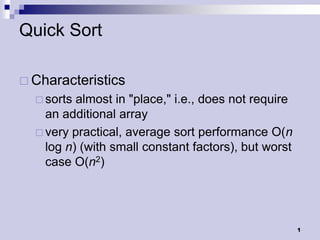
Lec10
- 1. Quick Sort Characteristics sorts almost in "place," i.e., does not require an additional array very practical, average sort performance O(n log n) (with small constant factors), but worst case O(n2) 1
- 2. Quick Sort – the Principle To understand quick-sort, let’s look at a high-level description of the algorithm A divide-and-conquer algorithm Divide: partition array into 2 subarrays such that elements in the lower part <= elements in the higher part Conquer: recursively sort the 2 subarrays Combine: trivial since sorting is done in place 2
- 3. Partitioning Linear time partitioning procedure Partition(A,p,r) i i j j 01 x A[r] 17 12 6 19 23 8 5 10 02 i p-1 03 j r+1 X=10 i j 04 while TRUE 10 12 6 19 23 8 5 17 05 repeat j j-1 06 until A[j] x i j 07 repeat i i+1 08 until A[i] x 10 5 6 19 23 8 12 17 09 if i<j 10 then exchange A[i] A[j] j i 11 else return j 10 5 6 8 23 19 12 17 3
- 4. Quick Sort Algorithm Initial call Quicksort(A, 1, length[A]) Quicksort(A,p,r) 01 if p<r 02 then q Partition(A,p,r) 03 Quicksort(A,p,q) 04 Quicksort(A,q+1,r) 4
- 5. Analysis of Quicksort Assume that all input elements are distinct The running time depends on the distribution of splits 5
- 6. Best Case If we are lucky, Partition splits the array evenly T (n) 2T (n / 2) (n) 6
- 7. Worst Case What is the worst case? One side of the parition has only one element T (n) T (1) T (n 1) ( n) T (n 1) ( n) n (k ) k 1 n ( k) k 1 (n 2 ) 7
- 8. Worst Case (2) 8
- 9. Worst Case (3) When does the worst case appear? input is sorted input reverse sorted Same recurrence for the worst case of insertion sort However, sorted input yields the best case for insertion sort! 9
- 10. Analysis of Quicksort Suppose the split is 1/10 : 9/10 T (n) T (n /10) T (9n /10) (n) (n log n)! 10
- 11. An Average Case Scenario Suppose, we alternate L( n) 2U ( n / 2) (n ) lucky lucky and unlucky U ( n) L( n 1) (n) unlucky cases to get an we consequently get average behavior L( n) 2( L(n / 2 1) (n / 2)) (n ) 2 L(n / 2 1) (n ) n (n) (n log n ) n (n) 1 n-1 (n-1)/2 (n-1)/2 (n-1)/2+1 (n-1)/2 11
- 12. An Average Case Scenario (2) How can we make sure that we are usually lucky? Partition around the ”middle” (n/2th) element? Partition around a random element (works well in practice) Randomized algorithm running time is independent of the input ordering no specific input triggers worst-case behavior the worst-case is only determined by the output of the random-number generator 12
- 13. Randomized Quicksort Assume all elements are distinct Partition around a random element Consequently, all splits (1:n-1, 2:n-2, ..., n- 1:1) are equally likely with probability 1/n Randomization is a general tool to improve algorithms with bad worst-case but good average-case complexity 13
- 14. Randomized Quicksort (2) Randomized-Partition(A,p,r) 01 i Random(p,r) 02 exchange A[r] A[i] 03 return Partition(A,p,r) Randomized-Quicksort(A,p,r) 01 if p < r then 02 q Randomized-Partition(A,p,r) 03 Randomized-Quicksort(A,p,q) 04 Randomized-Quicksort(A,q+1,r) 14
- 15. Randomized Quicksort Analysis Let T(n) be the expected number of comparisons needed to quicksort n numbers. Since each split occurs with probability 1/n, T(n) has value T(i-1)+T(n-i)+n-1 with probability 1/n. Hence, 15
- 16. Randomized Quicksort Analysis(2) We have seen this recurrence before. It is the recurrence for the expected number of comparisons required to insert a randomly chosen permutation of n elements. We proved that T(n) = O(nlog2 n). Hence expected number of comparisons required by randomized quicksort is O(nlog2 n) 16
- 17. Randomized Quicksort running times Worst case running time of quicksort is O(n2) Best case running time of quicksort is O(nlog2 n) Expected running time of quicksort is O(nlog2 n) 17
- 18. What does expected running time mean? The running time of quicksort does not depend on the input. It depends on the random numbers provided by the generator. Thus for the same input the program might take 3sec today and 5sec tomorrow. The average time taken over many different runs of the program would give us the expected time. Same as saying that we are taking average over all possible random number sequences provided by the generator. 18
- 19. Analysis of insertion in BST When creating a binary search tree on n elements the running time does depend on the order of the elements. Our algorithm for insertion did not employ an random bits. Given a specific input order the algorithm takes the same time each day. However, the time taken is different for different input orders. The average time taken over all possible input orders is O(nlog2 n). 19
